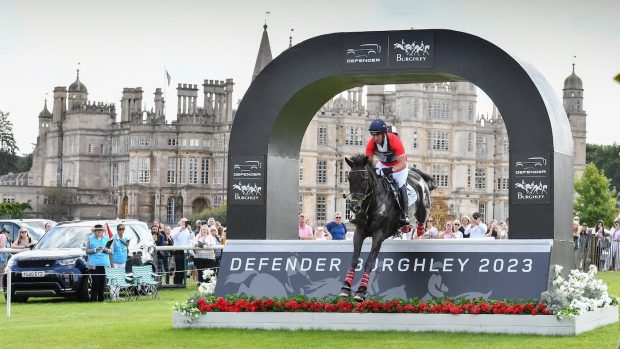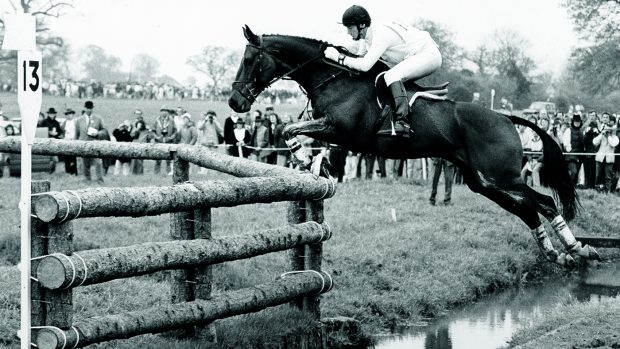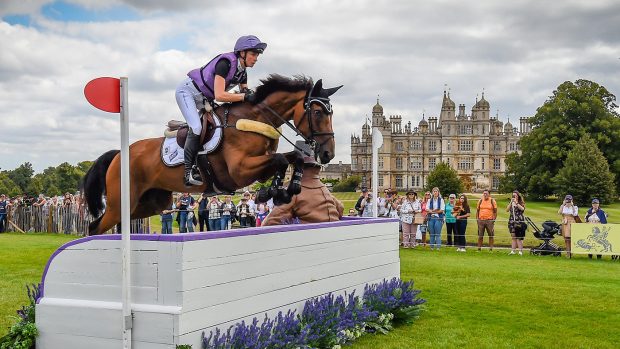Burghley’s iconic fences have remained since its first running 61 years ago. Catherine Austen traces the history of the Leaf Pit, the Trout Hatchery and more
A large part of the draw for spectators to a major horse trials is the chance to walk the cross-country course, marvel at the size and complexity of the fences, and see what the course-designer has done this time at familiar and famous questions, with the famous Burghley Horse Trials cross-country jumps being no exception.
The Leaf Pit, the Trout Hatchery, the Dairy Mound – fans instantly associate those names with Burghley, in the same way that Huntsman’s Close and the Vicarage Vee mean Badminton. But, while Badminton’s adjustments to the course over the years mean that we no longer watch riders through Luckington Lane or Tom Smith’s Walls, Burghley’s iconic features have remained constant since day one. Most were created by Bill Thomson, Burghley’s first course-designer.
“That’s something Burghley has done that Badminton hasn’t,” says former Burghley course-designer Mark Phillips. “I first rode there in 1967, and you had the Leaf Pit, the Trout Hatchery, the Dairy Mound, Capability’s Cutting…”
“I think that continuity makes people feel at home,” says Bill Henson, event director for 16 years until his retirement in 2003. He rode at Burghley in its very early days, admitting that he got eliminated at Capability’s Cutting.
“The Leaf Pit has always been called that – it was where the gardeners came to get rid of the leaves every year when they were cleaning up the park,” he says.
Philip Herbert has been closely involved with Burghley since 1981. He designed the course for five years in the mid-1980s and is still clerk of the course today. He says: “There have been various incarnations of the Leaf Pit step, but it has always been a two-metre drop and always in exactly the same spot.”
He remembers Mark Hall and Herringfleet refusing on the top of the mammoth drop, and Mark dismounting, jumping down the drop on his feet and trying to pull the horse down after him. Unsurprisingly, the horse jibbed.
The increased technicality of five-star eventing means now there are additional fences after – and sometimes before – the drop, but that leap of faith remains the same.
Five-time Burghley winner Ginny Elliott says: “Lady Hugh Russell said you must trot [to a drop]; she was right, because you landed very softly and in much better balance that way.”
Trout breeding
The Trout Hatchery is Burghley’s principal water feature, and the only one until about 2000, when the water question under the Lion Bridge was developed, while the Anniversary Splash was created for the event’s 50th anniversary in 2011.
Trout were indeed originally bred in the pools at the Trout Hatchery, and Philip remembers finding trout in there in his early days at Burghley. Photographs from the 1960s and 1970s show a fairly basic-looking pond, with weeds growing in it – with some very upright rails perched on the slope in.
Bill Henson says: “I remember Merely-A-Monarch [the first winner of Burghley, in 1961, with Anneli Drummond-Hay] looking like he was going to stop at a tiny little rail going into it. Obviously he didn’t!”
Mark says: “In 1974 we came down the hill to the bottom Trout Hatchery and jumped two skinny little rails – Jesus Christ, it was big!”
He added the top-most, splash-through pool a few years ago. “What didn’t really work there was riders going straight across the higher pool – it’s a perfect half-stride distance, whichever way you go, so I sent them across on an angle to get a more regular stride,” he says.
Philip remembers Mark himself coming to grief at the lower Trout Hatchery. “He got eliminated, then wanted to find his way home so rode the outside edge of the obstacle, where it wasn’t designed to be ridden over, and the horse disappeared up to its belly in mud and filth,” he says.
Capability’s Cutting, the steep-sided gully named after “Capability” Brown, the great 18th century landscape architect who designed the layout of Burghley’s parkland and gardens, has always been a feature among the famous Burghley cross-country jumps on course.
“It was a major obstacle in days gone by; perhaps less so now,” says Philip.
Ginny says: “In my day it was a key fence, and a very good one for spectators. There was always some large palisade on the edge of the cutting which we couldn’t figure out how on earth we would attempt.”
Bill Henson adds that Burghley’s head forester, Peter Glassey, obtained the 300-year old plans of what Capability Brown intended to do: “Peter has been replanting them, re-establishing the old lines of the trees, and looking ahead to Burghley’s next 300 years.”
New developments
Incoming title sponsors have brought with them developments to the course; there have always been fences in what is now Defender Valley, but its name was initially changed to Discovery Valley when Land Rover took over the sponsorship. The Dairy Mound – the collection of slopes near the old dairy farm – was renamed Clarence Court for a time after its fence sponsor, but whatever it is called, the test it poses is always a considerable one. And Rémy Martin’s support meant that, in 1983, Bill Thomson designed a timber “brandy glass”, which Ginny describes as “the most difficult angled fence I’ve ever jumped.”
“I walked it to go the straight route, but thought that if I was on time, I would go long, which was much safer,” she remembers. “But my watch stopped and I didn’t know whether or not my time was OK. Malcolm Wallace and Louise Bates were standing there and apparently said, ‘She’s OK for time, she’ll go the long way,’ but I felt I had to jump it straight!”
As Kate Green says in The Little Book of Burghley, Ginny “took a breathtakingly perfect line on Priceless, jumping the two curving rails of the ‘bowl’ of the glass and the corner where the ‘stem’ met the ‘foot’ of the glass without a single break in rhythm.” After that, Ginny and Priceless were deserving winners.
Some of the legendary Burghley questions, have been lost and then reinstated. This year the Waterloo plain of undulating mounds uphill from the Trout Hatchery is making a return. It’s an area of the course that Philip missed when it was removed, saying: “It’s an amazing feature with all those ups and downs, and you could do a lot of interesting things there.”
Another five-time winner, Andrew Nicholson, didn’t miss it so much. The video clip of his incredible “save” there in 2000 on Mr Smiffy is still a YouTube favourite.
“I definitely got the jitters about the Waterloo Rails – there was a socking big fence there,” says Ginny. “And I can recall a massive bullfinch with a huge ditch in front on the 1985 track that really spooked me.”
It was the fourth fence on Philip Herbert’s course, and French rider Jean Teulère was cheered by the crowds when he was the first rider to clear the direct route. It didn’t cause Ginny any problems – she and Priceless won for the second time, and were crowned European champions.
‘The world’s toughest five-star’
If the questions themselves still hold the same names, the actual course the horses gallop on is greatly improved.
“When Bill Thomson got started at Burghley, the park was very badly kept,” says Bill Henson. “It was a tip, it really was, and Bill had to find places between the nettle patches to put the fences!”
Philip Herbert developed the permanently fenced-off, properly irrigated track Burghley now boasts. “When I started irrigation, I realised there was no point if the course wasn’t fenced off, as the sheep just devoured the lovely green grass the irrigation created,” he says.
Gradually it was all fenced, and the irrigation system evolved into permanent pipework controlled electronically.
“I think we are the only cross-country course – in this country, at least – that has an in-ground irrigation system,” he says.
Burghley’s undulating and varied terrain means it has a claim on the label “world’s toughest five-star”, even when the ground conditions are perfect.
Mark Phillips explains: “Put Burghley in the context of the sport changing. Once you had a steeplechase of 5min 13sec, and a cross-country course of around 13, 14 minutes with a distance of 185m per effort. Now we have 140, 145m per effort, so the intensity is much greater; therefore the terrain plays a much greater part.
“Once horses became tired because of the endurance element; now they are tired because of the intensity. Fifty years ago the fences were the same size as they are today, but 50 years ago you had much more time between fences. But a shorter course and the demands of TV mean that fences are clustered together more.”
The Cottesmore Leap
The yawning ditch and hedge at the highest point of the course is one of the most famous Burghley cross-country jumps – and the most photographed cross-country fence in the world.
“Until the late 1980s it was actually a sunken wall,” says Burghley’s clerk of the course, Philip Herbert. “The gully, which is six metres across, had a wall in the middle, which meant horses took off in the grassy ditch and landed on the face of the other bank.”
It was then turned into its present incarnation and named the Centaur’s Leap, because event sponsor Rémy Martin had a centaur as its logo.
Bill Henson adds: “When Pedigree Chum took over the sponsorship, the managing director Mr Dale wanted to change it. His wife hunted with the Cottesmore, so it became the Cottesmore Leap.”
Various top combinations have fallen foul of it, including Pippa Funnell and Sir Barnaby – but only one person has jumped it backwards.
“When the draghounds used to meet here at Burghley, someone must have jumped it the wrong way – with the ditch behind – for a bet, because I could see the hoofprints on the take-off boards!” says Philip. “Poor horse – that ditch must have come as a nasty surprise.”
You may also be interested in…
Burghley heroes: 10 of the greatest horses
From the inaugural winner to a modern-day star, Ellie Hughes, Catherine Austen and Pippa Roome pick Burghley’s horse heroes

#ThrowbackThursday: Burghley Horse Trials 2014 video round-up of all the best bits
Take a look back at the action from the 2014 Land Rover Burghley Horse Trials via these daily video reports,
Throwback to fresh horses and snappy dressers at Burghley 2008 trot-up
As today should have been the day of the first horse inspection, enjoy some videos from the Horse & Hound

Burghley confirms new course-designer from 2021

Subscribe to Horse & Hound this spring for great savings
Horse & Hound magazine, out every Thursday, is packed with all the latest news and reports, as well as interviews, specials, nostalgia, vet and training advice. Find how you can enjoy the magazine delivered to your door every week, plus options to upgrade your subscription to access our online service that brings you breaking news and reports as well as other benefits.




